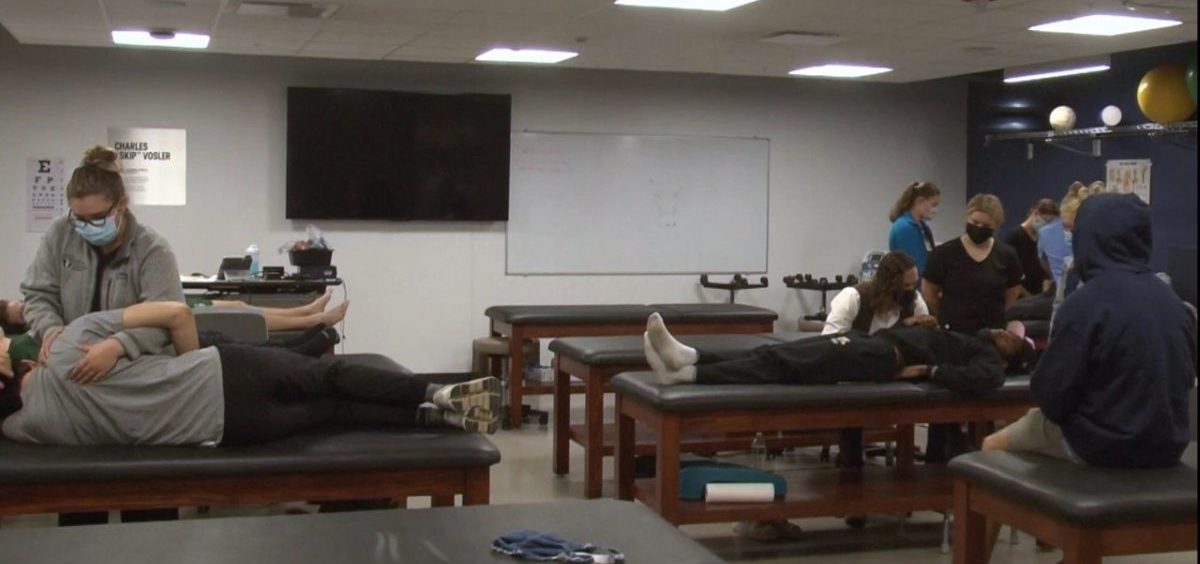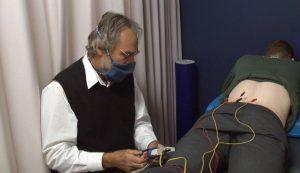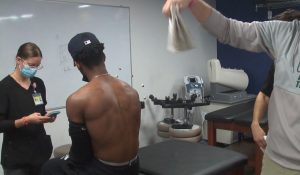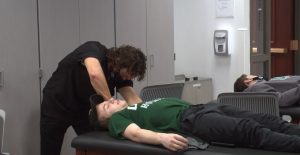
OU HCOM Offers Unique Opportunity for Students, Hockey Players
By: Joe Collins
Posted on:
ATHENS, Ohio — The grind of a long hockey season can be tough on the body of a player. They get banged up, sore, and always have to find a way to fight through it to play. On their rest days, they need a sufficient way to heal. To do this, they usually visit with their trainers and go through various exercises to help them heal. However, for the Ohio University Ice Hockey team, they have something a little different.
Members of the hockey team go every Sunday to Grover Hall to attend an OMM (Osteopathic Manipulative Medicine) clinic, put on by professors and medical students at the Ohio Heritage College of Osteopathic Medicine. The clinic is led by OU professor and Osteopathic Physician, Dan Black.
“Over the last five years, we’ve been building a musculoskeletal clinic that is alternative medicine, sort of an east meets west phenomenon, Black said. The players love it, and we have students that are learning at all levels of osteopathic training.”
Hands on Experience
The clinic allows for MS (Medical Step) levels one, two, three and four’s, which are the levels of experience for a medical student, to get hands on experience with people who have injuries and abnormalities with their bodies. This allows the students to have more knowledge of both common and uncommon problems with the human body when it comes to contact sports. The idea of having a clinic made sense when you consider the location of Grover Hall and Bird Arena, which sit right next to each other.
“We started this about three or four years ago realizing that hockey is obviously a contact sport,” Black said. “Our guys were being injured, and we have a medical school literally across the way from the Arena. All the students early on need to start their careers feeling bodies and feeling abnormalities. The team presents that opportunity, and the students are eager to get that kind of learning.”
The program has not only allowed the medical students of the HCOM to get hands-on experience with the players, but it has also allowed the hockey team’s athletic trainers to learn from the medical students and vice-versa. They’ve even been able to accompany one another to the home hockey games to get live experience as well.
“I started as an OMS one working under the supervision of a second year said Casey, a fourth-year student at OU HCOM. I’ve been lucky enough to come back here in my fourth year and I’ve been able to go to games with Dr. Black and helping the athletic training team for hockey.”
“We have athletic trainers, Dr. Black pointed out. Dr. Chad Starkey has been working with me and has had me work with the various athletic trainers. Our students are graduate level athletic trainers, and with their guidance, we have the players come in here every Sunday after home games and allow our students to sort of feel their broken bodies.”
Unique Medical Practices
At the clinic, the MS level ones and twos would start with more simple medical practices like stretching and feeling around the players body for discomforts and offering relief to those areas.

The higher-level MS’ and professors conducted some more advanced medical techniques, one an electric form of acupuncture. The process involved inserting stainless-steel acupuncture needles into the soft tissue around the lower back, and the top of each needle was full of copper. The copper would act as a battery. The process is called percutaneous electrical nerve stimulation. It involves clipping electrodes on to the copper parts of the needles connected to a remote device. The device then produces an electric current stimulating the nerves.

Another process is transcutaneous electrical nerve stimulation, like percutaneous, except in involves pads on the nerves and muscles rather than the needles.
One of the more peculiar medical practices conducted during the clinic was fire-needle acupuncture. Needles would be inserted into the back of the patient, the tops of the needles are lit. A controlled fire at the top is extinguished as the burnt end of the needle provides heat therapy to the patient’s nerves and muscles.
For the more experienced medical practitioners, the clinic has been a beneficial experience for the MS one’s and two’s. With classes being online the past year due to the pandemic, this is one of the first chances to get hands-on experience in class.
Helps Younger HCOM Students
“These clinics are great because a lot of times when we’re training in our OMM labs, we’re training on other students who are usually pretty healthy and don’t have a lot of disfunction,” said Nathan Greg, an OMS two. “In here we get to see people who have dysfunctions, and we can actually treat it in real-time and see the results.”

Greg is one of many younger HCOM students who has been able to use what he’s learned in the clinic.
“OU really does give us a lot of opportunities to really work with the sports teams here. My first year when I went home for Christmas break, I remember going home and being like ‘Oh yo we can do this.’ My friends would be talking about some pains they’d been having and I’d be like ‘ok let’s try this technique,’ and they’d say how they really felt better afterwards. This whole experience really started getting me more into it.”
The clinic will continue throughout the season.

